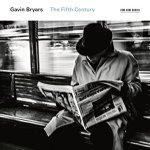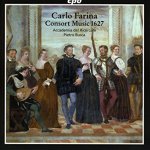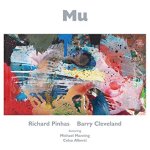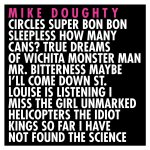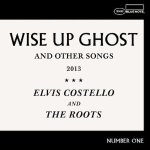CLASSICAL

Philip Glass
Maya Beiser x Philip Glass
Maya Beiser
Islandia Music
No cat. no.
For those who think Philip Glass’s music is mostly a bunch of endless arpeggios, cellist/arranger/producer Maya Beiser is here to set you straight. On this album she has arranged several of Glass’s piano etudes, the concert pieces Mad Rush and Music in Similar Motion, and selections from his opera scores for multitracked cello, and her arrangements demonstrate not only the complexity of Glass’s music but also his gradual evolution from repetitive minimalism into a sort of neo-Romantic expressivism. Those familiar with her work won’t be surprised by the virtuosity or the richness of her tone, but the inventivenss of her arrangements is also exceptional. A release for all libraries with a collecting interest in contemporary classical music.

Šimon Brixi
Music from Eighteenth-century Prague
Hipocondria Ensemble / Jan Hádek
Supraphon (dist. Naxos)
SU 4293-2
I’m really a sucker for world-premiere recordings of relatively ancient music — I love listening to music and thinking about the fact that it hasn’t been previously heard by anyone currently alive. And when the music is exceptionally beautiful, that makes the experience even more exciting. Šimon Brixi was a member of a distinguished Bohemian musical family (with genealogical connections to the celebrated Bendas); born at the end of the 17th century, he settled in Prague in his early 20s and began studying the law. But he abandoned the law for music and established himself as a church organist and composer. Despite significant regional renown, fewer than 40 of his works have survived. This outstanding recording features a Mass and a Magnificat setting, along with several briefer sacred works. All but the Magnificat are recorded here for the first time; the Hipocondria Ensemble (on period instruments) play with a lovely balance of lightness and solidity, and the singing of soloists Hana Blažíková and Jaromír Nosek is particularly noteworthy. For all collections.

Georg Benda
Piano Concertos
Howard Shelley; London Mozart Players
Hyperion (dist. Integral)
CDA68361
And speaking of the Benda family: I’ve been monitoring the Hyperion label’s The Classical Piano Concerto series with great delight ever since it was instituted in 2014. Now on its eighth volume, the series brings us four concertos by Georg Benda, a contemporary of C.P.E. Bach and Johann Stamitz better known today for his theatrical work than for his concert pieces. But pianist Howard Shelley and the London Mozart Players (all playing on modern instruments) make a powerful case here for Benda’s skill and even his importance in the latter arena, demonstrating how he helped build the bridge that linked the end of the baroque era with the beginning of the classical. Playing with relatively small forces (strings only apart from the piano soloist), Shelley and his group demonstrate Benda’s mastery of idiom and his forward-thinking structural ideas, and the entire album is a delight. Highly recommended to all classical collections, along with the previous volumes in the series.

Pierre-Gabriel Buffardin
Flute Sonatas & Concerto
Le Petit Trianon
Ricercar/Outhere (dist. Naxos)
RIC 428
These completely delightful chamber works for flute and strings (plus bassoon) come from the pen of celebrated flutist Pierre-Gabriel Buffardin, who is believed to have traded flute lessons for composition training from Johann Jacob Bach, brother of Johann Sebastian. He was a musician in the Dresden court in the early 18th century, and later spent many years in service to the King of Poland. This program features three sonatas and one chamber concerto, all of which showcase Buffardin’s unusually sweet lyricism and are exquisitely played by the Geneva-based ensemble Le Petit Trianon, featuring flute soloist Olivier Riehl. Strongly recommended to all classical collections.

Louis de Caix d’Hervelois
Dans le sillage de Marin Marais: Pièces de viole et autres oeuvres
La Rêveuse
Harmonia Mundi (dist. Integral)
HMM 902352

Henry Purcell
Fantazias
Chelys Consort of Viols
BIS (dist. Naxos)
BIS-2583
Henry Purcell, one of England’s greatest composers, was only 20 years old when he composed his set of fantasias and In Nomines for an unspecified consort of instruments. He was creating surprisingly old-fashioned music for a young court composer, and it’s possible that these pieces served primarily as compositional exercises for him; nevertheless, they show his budding genius and are exceptionally lovely. The Chelys Consort of Viols makes a strong case both for their significance in Purcell’s oeuvre and for their attractiveness as chamber music. A few years later, across the Channel, the viol was still in fashion as a solo instrument and as a featured element in a “broken” consort (an ensemble of different instruments). In France, Marin Marais was the undisputed king of the viol, and a new recording by the La Rêveuse ensemble features the work of one of Marais’ little-known students: Louis de Caix d’Hervelois. He came into his own in the Regency period of the early 18th century, and wrote for both the five-string pardessus de viole and for the transverse flute, which was just coming into fashion. This program consists primarily of suites written for viol and continuo (the latter played by varying combinations of bass viol, theorbed lute, and harpsichord) plus one suite for traverso and continuo and several brief transcriptions for viol and for solo lute and guitar. This is gentle music, elegant in a rather self-effacing way, but quite inventive and beautifully played. I might have wished for a slightly warmer and more colorful recorded sound, but this is an excellent album overall.
JAZZ

Dave Miller Trio
The Mask-erade Is Over
Summit (dist. MVD)
DCD 784
One of the things I love about pianist Dave Miller is the way he combines disciplined, fleet-fingered linear technique with a lush, almost orchestral sound. Not as lush as Errol Garner or Bill Evans, and not as linear as, say, Bud Powell, but Miller’s style hovers somewhere on the spectrum between those artists, moving easily along that spectrum, sometimes in the course of a single tune. His latest album (with its somewhat prematurely optimistic title) is a joyful romp through a program of standards including several classic bop tunes (he opens with a thrilling take on Charlie Parker’s “Anthropology”), American Songbook standbys, and a couple of relatively obscure numbers. Bassist Andrew Higgins and drummer Bill Belasco accompany him more than ably, and Belasco’s subtle brushwork is a particular highlight.

Gordon Grdina
Pendulum
Attaboygirl
ABG-1
Gordon Grdina is back with a third solo album of pieces for guitar and oud (a fretless lute used in many Middle Eastern cultures). The music is a mix of fully composed and improvised pieces. On some of them you can hear jazzy and even bluesy influences poke through (most notably about halfway through “Benbow Blues”), and on others he explores more Arabic melodic ideas (“Wayward”). But much of the time this music is culturally unidentifiable, functioning as an expression of Grdina’s unique and unbelievably nimble musical mind. It’s not that he doesn’t respect or acknowledge his musical debts, just that he takes his influences and runs with them in a variety of directions, none of which can easily or accurately be pigeonholed as an expression of any one particular musical genre. You’ll find him in the Jazz section because that’s where he’s tended to be in the past, but jazz fans will scratch their heads at this release. And I mean that in a good way.

Futari
Underground
Libra
202-069
And while we’re exploring the misty borders of jazz/no-jazz, let’s check out the most recent release from pianist/composer Satoko Fujii. Futari is the name of her duo project with vibraphonist and marimba player Taiko Saito, and they’ve been working together for some years now as an improvising duo. When COVID forced the cancellation of a planned tour last year, they decided to create music together remotely, by exchanging sound files. Interestingly, this led to a creative process that was still improvisational, and yet allowed the possibility of multiple takes for each musician before the final version was settled upon. How’s the music itself? As gorgeous and complex as one would expect from these two players, sometimes knotty but mostly highly approachable. Saito plays with a bow quite a bit, and some of the album’s most delightful moments (such as the exceptional “Break in the Clouds”) are defined significantly by the contrast between Saito’s floating vibes chords and Fujii’s gentle, pointillistic piano lines. This is a marvelous album overall and would make a welcome addition to any serious jazz collection.

Doug MacDonald
Serenade to Highland Park
DMACMUSIC
No cat. no.
Leading a trio that also includes bassist Mike Flick and drummer Paul Kreibich, guitarist Doug MacDonald takes us through a lovely set that focuses on standards, and takes a couple of detours into original compositions. MacDonald is showing off his stylistic range here, veering happily from Latin classics (“Manhã de Carbaval,” “Brazil”) to subtly funky blues (“Next Time You See Me”), to fierce midtempo burners (“Dearly Beloved”). He’s also showing off his unusual facility for chord solos, which are everywhere and always fun. Flick and Kreibich give him the best and most solid support any leader could ask for. This is a great album all around.
FOLK/COUNTRY

George Jackson
Hair & Hide
Self-released
GJ-02
There is hardly a sound more archetypally American than the combination of fiddle and banjo, and on this album fiddler George Jackson celebrates that sound with a variety of A-list banjo players including Jake Blount, Brad Kolodner, and Catherine “BB” Bowness. He plays two tunes with each of them: a traditional number and a tune that he wrote for each banjoist with his or her particular playing style in mind. The result is an absolutely delightful kaleidoscope of tunes that shifts constantly from hardcore Appalachian mountain tonalities to the jazzier realms of newgrass — though it’s sometimes difficult to tell which tune is old and which one is new (except in the case of “Food, Coffee & Kisses,” which sounds a bit like, er, freejazzgrass). Notable here are the sounds of different kinds of banjos played in different styles: resonator-backed instruments played in Scruggs style, open-back banjos played using clawhammer technique, fretless gourd banjos, etc. This is a thoroughly delightful album.

Legendary Shack Shakers
Cockadoodledeux
Alternative Tentacles
VIRUS 508
As someone who grew up buying Dead Kennedys albums, it’s a little disorienting to be reviewing what amounts to a neo-country album released on the Alternative Tentacles label (and one that features former Dead Kennedys frontman Jello Biafra as a guest vocalist, no less). The music veers from relatively traditional bluegrass (“Tickle Yore Innards”) to chugging honky-tonk (“They Won’t Let Me Forget”) to a sort of queasy norteño (“Godforsaken Town”) to rollicking rockabilly (“U-Can-Be-a-Star”). And it does all of that within the first five tracks. Then we get a Texas polka. All of it is delivered with a deceptively loose-sounding tightness, and the lyrics are slyly subversive. Overall, this album is a real hoot.

SUSS
Night Suite (EP; digital only)
Northern Spy (dist. Redeye)
NS147
The world’s best (likely the world’s only) country-ambient supergroup is back again, this time with a digital-only EP of what has now become the band’s unique stock in trade: long-form instrumentals that employ classic country-music tropes (gently whining pedal steel, deeply twangy Telecaster licks, etc.) to create gorgeously abstract soundscapes — think of Brian and Roger Eno’s Apollo soundtrack, but wearing cowboy boots rather than a spacesuit. Don’t be fooled, though; this is music of significant sophistication no matter how easy it may be on the ear. My only quibble is that albums like this shouldn’t be EPs — they should be at least 70 minutes long. Once you’re in this mood you don’t want to come up to the surface again after only 19 minutes.
ROCK/POP

Deadlights
Deadlights
Thatwasmyskull Music
No cat. no.

Well Wishers
Spare Parts (digital only)
Thatwasmyskull Music
No cat. no.
Well Wishers is the nom de power pop of singer, songwriter, and multi-instrumentalist Jeff Shelton, also known as the frontman for the similarly-inclined Bay Area band Spinning Jennies, who broke up in 2004. Shelton has since released over a dozen albums under the name Well Wishers, and the most recent is a digital-only compilation of outtakes and unreleased tracks spanning a period of ten years. As always, Shelton’s feel for a hook and his love of multi-layered guitars (not to mention his fine voice and skillful harmony singing) create a perfect crunchy-pop listening experience. Interestingly, he’s established a musical side hustle as well: a dreampop/Britpop project called Deadlights. On Deadlights’ eponymous debut album Shelton’s sound is a bit denser and also a bit softer around the edges than his Well Wishers music. There’s a somewhat shoegaze-y vibe here on some of these songs — I sometimes get a lovely whiff of Cocteau Twins mixed with the Sundays — but the pure pop sensibility is still strong and Shelton’s voice is easily recognizable. Both of these albums would make a welcome addition to any library’s pop music collection.

Garza
Daydream Accelerator (digital only)
Magnetic Moon
No cat. no.
Rob Garza is better known as half of the legendary downtempo electronica duo Thievery Corporation, with whom for over 25 years he’s been the architect of a groundbreaking club vibe that fuses elements of Brazilian, lounge, dub, and trip hop sounds. Now breaking out as a solo artist, Garza has put together a wide-ranging album of club and dreampop tunes in collaboration with vocalists including Enemy Planes, Racquel Jones, and EMELINE. None of the music here will shock or startle a Thievery Corporation fan, but Garza is definitely charting his own territory here: you might expect a song titled “We Want Blood” to be somewhat aggro, but in fact it’s gently bumping dream-house; “Talkin” is solid but soft-edged dancehall, while “Swim to Shore” is dubbed-up synth pop with a gently insistent hook. Very nice stuff.

VILIFY
Illusion of Self (digital/vinyl only)
Ohm Resistance
63M OHM
The Ohm Resistance label bills itself as “specialists in subsonic grief-bass programming,” and if that description sounds a bit tongue-in-cheek, well, listen to a few of its releases and you’ll get it. That being said, the new Ohm Resistance release by Berlin-based artist Villify takes a somewhat softer and kinder tack than that of many other musicians on the label’s roster. This is definitely bass music, and it’s definitely dark and moody, but it’s also restrained and very carefully orchestrated. “Road to Eleusis” flirts with a drill’n’bass tempo but keeps the focus on floating chords and ethereal textures, and the title track does something similar, also incorporating unidentifiable shards of vocals; “Ultimate Complexity” brings a somewhat tribal flavor to the proceedings. All of it is deeply enjoyable and only slightly unsettling (and only in the best way). Highly recommended.

Birds of Passage
The Last Garden
Denovali (dist. Redeye)
No cat. no.
Alicia Merz is a New Zealander who records — quite sporadically — under the name Birds of Passage. She doesn’t share much with the public about her personal life, but based purely on the evidence of this, her fifth album, she’s not necessarily a life-of-the-party type. Song titles like “It’s Too Late Now,” “Worship My Flaws,” and “Petite mort” give you an idea of what to expect: shimmering soundscapes built out of exceeding subtle chord progressions played by radically fuzzed-out instruments; vocals whispered as much as sung; melodies that pile up as gently and quietly as feathers falling. Hooks? Eh, no. And yet the album is tremendously engaging and richly rewards a close listen.
WORLD/ETHNIC

Shjujaat Husain Khan; Katayoun Goudarzi; Shaho Andalibi; Shariq Mustafa
This Pale
Lycopod
LR 002109
This album was recorded with, in part, a non-musical purpose: to try to come to an understanding of how the United States — where 13th-century Sufi mystic Jalal al-Din Muhammad Rumi has been the best-selling poet for almost 20 years — could have succumbed to such broad and powerful anti-Muslim sentiment over the past several years. Katayioun Goudarzi (voice), Shujaat Khan (sitar), Shaho Andalibi (ney), and Shariq Mustafa (tabla) decided to make an album consisting entirely of setting of Rumi’s love poems, and the result is this quietly intense and utterly gorgeous recording. The COVID pandemic forced the quartet to record mostly asynchronously, but the production is so fine and the performances so empathic that you would swear they were all in the same room with you. And Goudarzi’s voice is a wonder. Highly recommended to all libraries.

Marcus Gad Meets Tamal
Brave New World (digital & vinyl only)
Easy Star/Baco
No cat. no.
Marcus Gad hails from New Caledonia, a French protectorate in the South Pacific; for several years now, he’s been engaged in an ongoing collaboration with French producer Tamal. The latest fruit of that collaboration is this outstanding album of music that could loosely be called reggae but that regularly strays far from the usual reggae formulas. “Sunshine,” for example, is written in 6/8, while “Break the Spell” is a sort of hip hop fusion and “Treasure” is more R&B than anything else. Gad’s adopted Jamaican accent provides the only link to reggae tradition in many cases, but it also serves as the continuous thread that holds the album’s many stylistic excursions together. Very nice overall.

Jhelisa
7 Keys, Vol. 2 (digital only)
Dorado
No cat. no.
If you recognize Jhelisa Anderson’s name, there’s a good chance it’s from her 1990s work as a funk-soul diva, releasing acclaimed solo work while also appearing alongside the likes of the Shamen, Massive Attack, Soul Family Sensation, and even Björk. in 2018, after a long hiatus from solo recording, she made an album of drone-based music for meditation titled 7 Keys. Now she’s back with 7 Keys Vol. 2 (the first volume is being reissued simultaneously), and on these two albums she creates tracks at different frequencies designed to activate different chakras (bodily centers of focus during meditation, as outlined in mystical strains of Hinduism). Thus, each track is named according to a particular frequency, and each is built on a single droned pitch, sung by Anderson — though other pitches are often layered quietly around the central one. Beats enter the picture as well, from time to time, and occasional melodic melismas. The result is an album that those so inclined can use as an aid to meditation, but can also serve as deeply relaxing New Age/ambient mood music.

